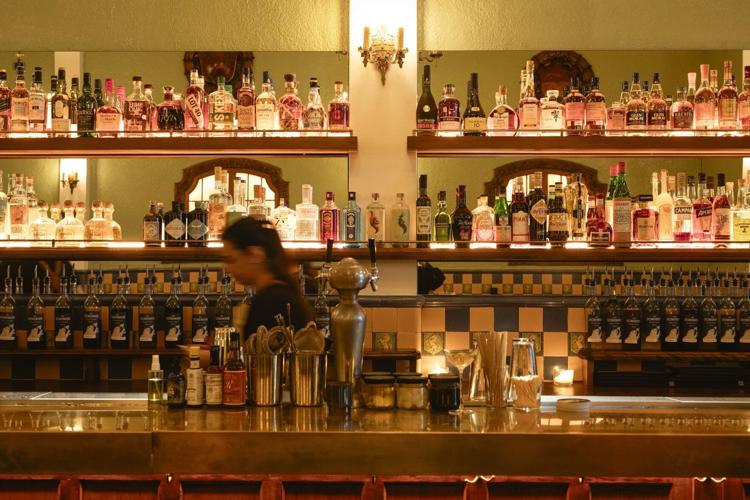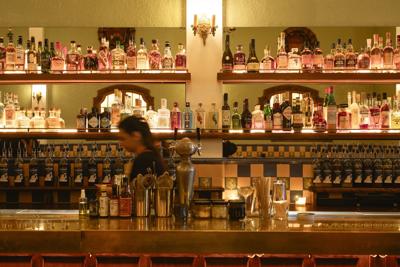âGoodbye Broadway, hello Montreal! With a stein upon the table, Iâll be laughing at you all.â
These lyrics are courtesy of Irving Berlinâs 1928 hit song, âHello Montreal!â â a celebration of the cityâs awesome jazz clubs, wild red-light district, and what may have been the best bar scene in North America.
Of course, there wasnât a lot of competition. Prohibition had shuttered bars everywhere in the United States since 1920. Canada was still a patchwork of wet and dry provinces, few of which had brought back the old saloon.
Quebec, on the other hand, chose to sit out the whole Prohibition trend. So Montreal, a.k.a. Canadaâs âSin City,â quickly became the alco-tourism capital of the north, rivalling Cubaâs Havana and Tijuana, Mexico, for both nightlife and notoriety.Â
Itâs still possible to drink in some of that storied past in modern-day Montreal, thanks to generations of bar owners whoâve done their best to preserve old spaces as sites of living history.Â
âIf you want to feel like youâre walking into history, one of the best is ,â says Kate Boushel, partner at Montrealâs award-winning Atwater Cocktail Club. âEven when it got a little rundown, the owners kept the barâs core essence and held on to the historic artifacts and decor, like the terrazzo floors and coats of arms hanging on the walls.â

At Bar Dominion, established in 1927, a sense of the past endures through the historic artifacts and decor.
Melika DezSome of the features in Bar Dominion, established in 1927, are now protected by HĂ©ritage Montreal, a historic preservation organization founded in 1975. Itâs a bar with a lot of past lives, but, somehow, all its stewards recognized good bones when they saw them. In its most recent incarnation, Dominion is a first-rate gastropub with a historically minded drinks program and stunning interiors that manage to simultaneously evoke the Roaring â20s and feel warm and welcoming.
One of Bar Dominionâs owners, Andrew Whibley, is also a partner at , a restaurant that opened last year on the ninth floor of the Montreal Eaton Centre, in a long-shuttered space that was, in 2000, classified as a historic monument.Â
Designed by architect Jacques Carlu, the space is a sprawling and spectacular example of art deco opulence thatâs been painstakingly restored to its original circa-1931 glory, including a chic little hidden gem of a bar, Le French Line, tucked away just after the host stand. With original deco art, a grand piano and a killer view of the neo-Gothic Christ Church Cathedral, itâs an ideal place to enjoy some oysters and cocktails inspired by the history of the space.

Le French Line is a chic little bar inside Le 9e, a restaurant that recently revived a historic art deco space inside Montreal Eaton Centre.
Folly Arts & MediasâI definitely appreciate (heritage) programs like this in Quebec, because it does help you hold on to the past,â says Whibley. âI think Le 9e and Dominion are good examples of projects that add a little bit of specialness to the city.âÂ
That specialness can also be found in other, less rarefied bars, including interwar taverns like Mount-Royalâs , open since 1922, where you might still find a beer stein on the table. , a 98-year-old bar near Place des Arts, can give you a really good sense of what drinking in a classic Quebec tavern was all about â but with a well-curated back bar.
Some old taverns have made big changes. Others, like in Old Montreal, donât inhabit historic bar spaces but still pay tribute to the cityâs legendary taverns by lovingly recreating them. Itâs a great spot to stop in after dinner at the nearby , first licensed in 1754.

The Atwater Cocktail Club tries âto balance art deco with disco,â channelling the energy of the bars that made Montreal famous 100 years ago.
Atwater Cocktail ClubAt the end of the day, though, you donât have to go to an ancient bar to get a feel for the excitement that travellers experienced in the 1920s. Itâs pretty easy to dial into that vibe in so many of the cityâs best bars, from the chic tiki hotspot to the , which has always tried to resist tying itself too closely to the past.  Â
âEven though you enter the bar through a back door in an alley and thereâs a red light out there, we donât call the bar a speakeasy,â says Boushel. âWe donât play jazz. But we try to balance art deco with disco, so we can channel the upbeat and bustling energy of the bars that made this city famous 100 years ago.â
Christine Sismondo is a Toronto-based writer who specializes in bars and cultural history, as well as an academy chair (Canada East) for the Worldâs 50 Best Bars.



















































To join the conversation set a first and last name in your user profile.
Sign in or register for free to join the Conversation